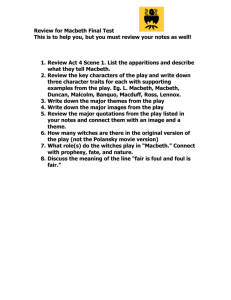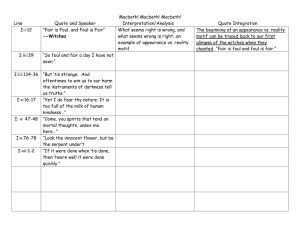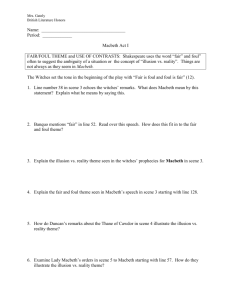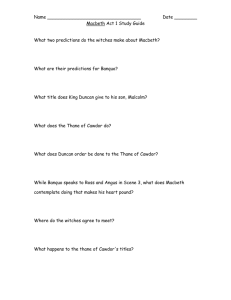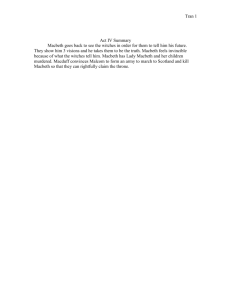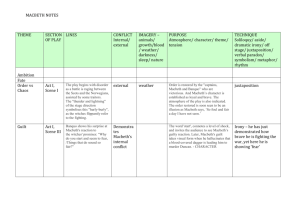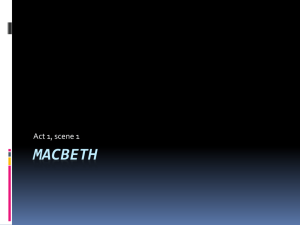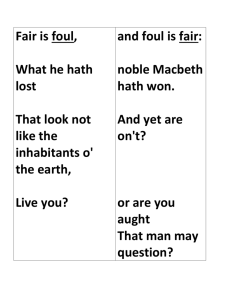Macbeth Analysis and Discussion for Questions 1 and 2
advertisement
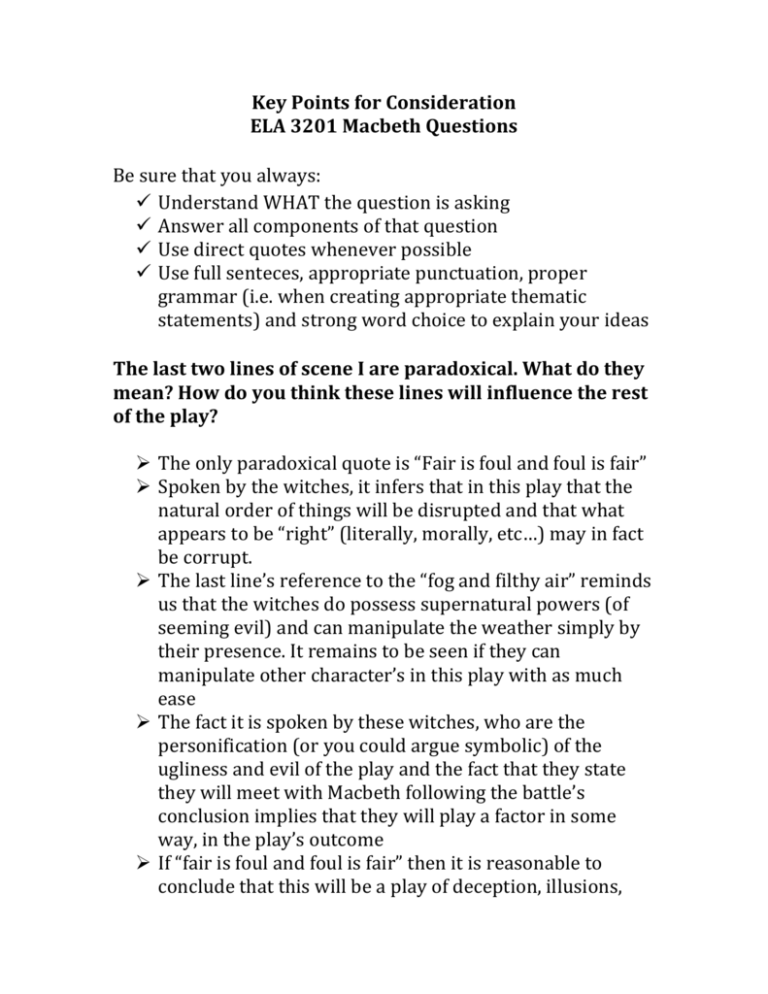
Key Points for Consideration ELA 3201 Macbeth Questions Be sure that you always: Understand WHAT the question is asking Answer all components of that question Use direct quotes whenever possible Use full senteces, appropriate punctuation, proper grammar (i.e. when creating appropriate thematic statements) and strong word choice to explain your ideas The last two lines of scene I are paradoxical. What do they mean? How do you think these lines will influence the rest of the play? The only paradoxical quote is “Fair is foul and foul is fair” Spoken by the witches, it infers that in this play that the natural order of things will be disrupted and that what appears to be “right” (literally, morally, etc…) may in fact be corrupt. The last line’s reference to the “fog and filthy air” reminds us that the witches do possess supernatural powers (of seeming evil) and can manipulate the weather simply by their presence. It remains to be seen if they can manipulate other character’s in this play with as much ease The fact it is spoken by these witches, who are the personification (or you could argue symbolic) of the ugliness and evil of the play and the fact that they state they will meet with Macbeth following the battle’s conclusion implies that they will play a factor in some way, in the play’s outcome If “fair is foul and foul is fair” then it is reasonable to conclude that this will be a play of deception, illusions, destiny/fate and moral questioning as to what is right and wrong in both the physical (weather, battles) and moral (beliefs, decisions, consequences) world How are theme and atmosphere developed in the first scene? Explain. When discussing atmosphere, it is critical that you: Find an appropriate and descriptive word to captivate the overall feeling of the scene/moment (good, bad, happy, sad, bad, angry, nice, etc…are VERY vague and not appropriate) Beyond this, you have to use other literary elements to convey how this atmosphere exists. The general ‘go-to’ elements to help with this are conflict, setting, and the diction/word choice used in the section – but you are also not limited to these In this scene, you could consider the following descriptive words, based on your interpretation of the opening scene: - Gloomy - Sinister - Dark - Uneasy - Tense - Eerie - Morbid There are many others as well. Again, it’s key that you connect appropriate quotes or ideas to whichever you pick. The quotes are NOT interchangeable with the terms. To help “prove” this atmosphere exists, you must now actually prove it through the use of OTHER literary devices employed by Shakespeare. Conflict: The raging battle in the distance The ‘appearance’ of the witches and corruptive influence on nature (external) Setting: Thunder and Lightning Rain The fog and filthy air (all caused by the witches’ appearance) A disruption of the natural order Foreshadowing: That they will meet later with Macbeth and that “fair will be foul”, implying a sinister/meddlesome influence OR that Macbeth is already in collusion with the weird sisters Diction: That the battle will be both ”lost and won” (paradox – but how?) That they will meet later in a barren “heath” Discussion of the “hurlyburly” (war) The calling out of a paddock (toad) and Graymalkin (cat) which are both “familiars” of demons and witches The “fair is foul and foul is fair” antithesis (and theme) which helps to create that dark and uncertain atmosphere through paradoxes, unfulfilled (yet) promises of evil, and double meanings The suggestion therefore that Macbeth’s world is one where the moral order has been reversed and where it is difficult to tell the difference between “right and wrong” That the witches speak in incantations and rhythmic grotesque chanting rather than blank verse This then ties into THEME With theme, remember that as Level III students you must successfully transition/alter/modify a theme into a thematic statement before having a full discussion. For example: “Fair is Foul and Foul is Fair” is a major theme in this play. However, it is not a thematic statement. On its own, without further analysis it is simply an antithesis. It is a quote spoken by the witches which permeates throughout the play, but nothing more. A theme you can develop from this might be: - The theme of deception OR - That good is bad and bad is good - Appearance vs. Reality But these are still not thematic STATEMENTS A statement might be: - Appearances can be deceptive - Things are often not what they seem - Nothing is as it seems - Most people see what they wish to see, not what is really there - When you are practicing to deceive, things often do not turn out how you expected. - But whatever you DO choose, you have to put it into your own words and context or it ends up being grammatically awkward in your writing. A poor way to write this might be: “One way in which ‘Nothing is as it seems’ occurs in this play Macbeth by William Shakespeare is when….” As opposed to…. The re-occurrence of deception and it’s impact on the natural world can be found when the witches discuss….
